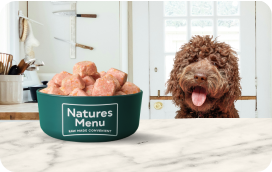Quick takeaways about ultra-processed dog food
- Ultra-processed dog food is industrially made and includes traditional kibbles and wet foods.
- Studies have shown strong links between a diet high in ultra-processed foods (UPF) and diseases like cancer – in humans and dogs.
- Feeding a whole, raw diet protects dogs against disease and improves their gut, skin and immune health.
There’s no denying it – a diet high in ultra-processed foods is bad for us. Medical research into UPF has almost tripled since 2020, and studies have shown strong correlations between this type of food and diseases like cancer, heart disease and obesity. Eating lots of it could even speed up the ageing process.
The Brazilian nutritional scientist Carlos Monteiro coined the term ‘ultra-processed foods’ 15 years ago after he noticed that Brazilian households were spending less on sugar and oil, yet obesity rates were increasing.
His 2011 study suggested this was caused by increased consumption of highly processed food, with added preservatives, flavourings, and vital nutrients removed.
“There are huge parallels between the research on the effect of UPF on humans and dogs,” explains veterinarian and raw food advocate Dr Nick Thompson. Researchers consistently point to the life-changing benefits of minimally processed foods over ultra-processed. Yet, more of us are eating and feeding it to our pets than ever.
According to Dr Nick, the average adult in the US gets 70% of their calories from UPF, and millions of dog owners are feeding their pets UPF foods like kibble day in, day out. Thankfully, more people are turning to whole and raw dog foods as we begin to understand more about dog health and nutrition.
Here, we ask Dr Nick to explain the potential effects of UPF on your dog’s health and wellbeing and why raw feeding could help them live healthier for longer.
What actually is ultra-processed dog food?
Ultra-processed dog foods are made by cooking ingredients at a high heat, which reduces their nutritional value. They also contain added artificial additives, dyes (to please the owner, not the dog!), preservatives and fillers – meaning the actual meat content is usually very low. All this makes UPF cheaper and gives it a longer shelf life.
“There’s an official definition for ultra-processed food,” explains Dr Nick. “It applies to human and dog food, and it’s called the NOVA classification system – developed by scientist Carlos Monteiro.”
NOVA Group 1 – unprocessed or minimally processed food
NOVA Group 1 is the food that comes straight from the farm or the source – so plants like fruits, vegetables, leaves and seeds, and animal products like muscle, offal, eggs and milk.
Minimally processed foods are natural foods where the inedible or unwanted parts have been removed or dried, crushed, ground, boiled, chilled or frozen.
NOVA Group 2 – processed culinary ingredients
“Group 2 is what you have in your kitchen to cook healthy food like oils, salt, butter and honey,” says Dr Nick.
NOVA Group 3 – processed foods
Processed foods are often made by combining group 1 with group 2 foods, using preservation or cooking methods. Group 3 foods include canned vegetables, pulses, fish or fruit, usually preserved in oil, brine or syrup.
It also includes some types of processed animal foods like ham, bacon, smoked fish, and simple cheeses.
NOVA Group 4 – ultra-processed foods
“These are what comes out of a food factory, and cannot be made in your kitchen” explains Dr Nick. They’re foods with lots of ingredients and are often industrially processed.
It usually starts with the breaking down of whole foods into substances like sugars, oils, fats, proteins, starches and fibre. For dog food, this might also include pureeing or grinding animal carcasses from livestock farming.
Many chemical additives are added to these foods, including:
- Artificial flavours and colours
- Preservatives
- Thickeners
- Stabilisers
- Emulsifiers
- Thickeners
- Gums
- Sweeteners
- Emulsifying salts
- Anti-foaming agents
- Bulking agents
- Carbonating agents
- Foaming agents
- Gelling agents
Ingredients are combined and put through processes never found in the kitchen at home. Poor-quality kibble and wet food are ultra-processed, while high-quality raw dog food is minimally processed.
Why have UPFs like kibble become such a popular way of feeding?
“Quite simply, it’s about margin and convenience,” says Dr Nick. “Big manufacturers take cheap ingredients, break them down and then put them together in all sorts of ways. They also tend to have long shelf lives – they’re cooked and preserved such that they could last forever.”
Is all dry dog food ultra-processed?
Not necessarily. Some dry dog foods might just count as ‘processed’ if they’re air-dried or lightly baked. However, most traditional kibbles are made using an ‘extrusion’ process. Big manufacturers create dough from powdered meat and bone meals, oils, grains, vegetables and vitamins and cook it at high temperatures (up to 200°C).
After cooking, they push it through holes to create little bites. It might be dried further, and extra colourings, flavouring, and fats may be added.
Health problems linked to UPF foods
“New research shows that ultra-processed food is linked to a whole host of preventable conditions and problems, including obesity, inflammation and disease,” says Dr Nick.
A large clinical trial by veterinarian Dr William Pollack found that 75% of common diseases in dogs could be prevented – without medical intervention and instead with diet changes, like feeding raw meat and whole food.
Here are some of the biggest health problems linked to UPF:
1. Obesity
“This is the biggest effect of UPF,” says Dr Nick. Plenty of recent human studies have found that diets rich in ultra-processed food are linked to overweight and obesity.
Around 75% of dogs in Western countries are carrying excess body weight – “And the biggest cause is ultra-processed food,” says Dr Nick. French and Belgian researchers found that switching overweight dogs from commercial dry foods to a high-protein, low-carbohydrate diet (like raw) resulted in up to 3% healthy weight loss.
2. Cancer
“A 2018 ongoing French study of 600,000 people found that every 10% increase in ultra-processed food causes a 10 to 12% increase in cancer risk,” says Nick.
One of the big reasons is UPF’s effect on insulin levels. “Ultra-processed foods like kibble and tinned food tend to be very high in refined carbohydrates. These break down into sugars, which bumps up insulin levels.
“Humans, dogs and cats are designed to live at a low level of insulin because refined grain carbohydrates and sugars were very rare throughout history until recently.
“Chronic exposure to too much insulin can be harmful. Insulin is a hormone that promotes growth, and every cell has insulin receptors. Therefore, regularly high insulin levels can negatively affect the body – from the brain to the heart and gut.
“It’s linked to diseases like cancer, Alzheimer’s, Parkinson’s, heart disease and IBD (inflammatory bowel disease).”
3. Faster aging
Another big issue with UPF is its connection to the ‘AGE’ reaction. “AGE stands for Advanced Glycation End-Products, which is when proteins and sugars come together during the cooking process of kibble or tinned foods,” says Nick. They form these end-products, which aptly can accelerate aging.
“They also damage and degrade the quality of tissues in the body, cause inflammation, and gum up the molecules of metabolism – it’s like pouring honey into a grandfather clock.”
4. Skin disease
One of the most common causes of dog skin problems is an allergy to the ingredients in ultra-processed foods – from gluten to degraded proteins. Studies show that dogs fed a raw meat-based diet have lower levels of inflammation and skin diseases. Simple.
5. Gut health
Research from the University of Helsinki found that puppies fed ultra-processed kibble were around 70% more likely to develop gut issues like IBD as adults than those fed raw.
Experts think that raw feeding teaches a dog’s developing immune system to form a healthy gut microbiome. This can help protect them against environmental allergens and generally strengthen their immune system.
How can you spot ultra-processed pet foods?
“Have a look at the ingredients,” says Nick. “If there’s a long list, or items you don’t recognise or that don’t sound like food, then the chances are it will be ultra-processed.”
Some of the common not-so-nice, highly processed ingredients in kibble include meat meal (made from parts of animals that aren’t allowed to be sold for human consumption), corn syrup, caramel colouring, gluten and meat ‘flavours.’
What’s the best alternative to ultra-processed?
“In my opinion, raw is the way to go,” says Dr Nick. “This is because it’s minimally processed and made with ingredients you can find in your own kitchen or buy at supermarkets or farmers’ markets.
“Only the enlightened dog owners are feeding some or all raw food. Granted, around 1% of dogs can’t tolerate it or are so used to eating ultra-processed that they find it difficult to switch. This is very rare though.”
“If you’re thinking that you don’t want to feed kibble any more, my advice would be to research and talk to a reputable raw food company. They can take you through the process.” Natures Menu has a handy transition guide to help you switch gradually.
“Variety is also a big benefit of feeding raw food,” says Dr Nick. “Big dry food brands might suggest one type of food for an adult dog – a single diet with the same ingredients every single day for life!”
“Just like with our diets, variety is more important than you’d think – it’s the ingredient that doesn’t go in the bowl.” And you can do this much more easily with whole and raw foods.
About Dr Nick
Dr Nick has been a veterinarian for 30+ years and runs Holistic Vet practice. He is a passionate canine raw food advocate and an expert in natural dog nutrition. He shares his knowledge with dog owners and experts across the world.
Further recommended reading by Dr Nick
Books:
- Ultra-Processed People by Dr Chris van Tulleken
- Metabolical and Fat Chance by Dr Robert Lustig
- Good Energy by Dr Casey Means
- Why We Get Sick by Dr Benjamin Bikman
- Wheat Belly by Dr William Davies
- Salt, Fat, Sugar by Michael Moss








